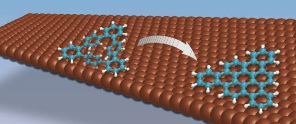New bottom-up strategies for molecular assembly to tailor-build new molecules
The appearance on the technological scene of new electronic devices based on organic molecules is awaited with much expectation since they promise to be inexpensive, flexible, faster and smaller than those based on silicon technology. However, molecular electronics faces important challenges before the jump from the research laboratory to the technological centre can be made. To make this jump one of the new trends in the field aims to assemble organic molecules at specific locations on nanostructured surfaces, where they can subsequently be used as building-blocks for fabricating the active or passive electronic elements of a circuit. Rather than using the current top-down techniques, successfully applied in solid-state electronics, it seems clear that the groundwork for building molecular devices should start with a bottom-up strategy, presently lacking in the molecular engineer’s toolkit…
Roman Fasel and co-workers have shown that is possible to synthesize nanographene, a highly strategic molecule, from less complex polyphenyls, demonstrating the capabilities of this new strategy for bottom-up fabrication, which can be easily extended to the assembly of nanographenes of varying dimensions
Read our complete opinion article in nature chemistry 3,11,2011


